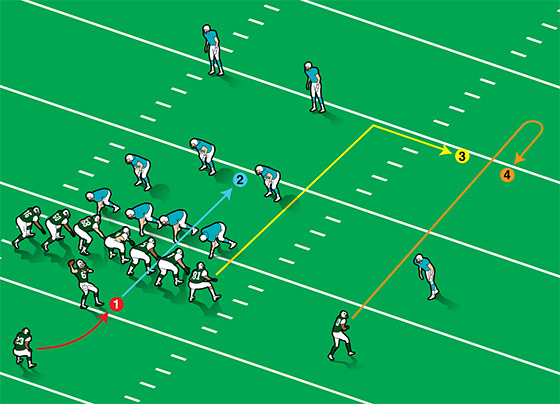
For Sanchez:
Mark Sanchez is a classic drop-back passer who excels at getting rid of the ball quickly. “When Mark is forced to hold the football, he gets into trouble,” Theismann says. In this play, Sanchez fakes a handoff to tailback Shonn Greene 1. “Shonn is a damn good rusher,” Theismann says, which means the fake should freeze the pass rushers and buy Sanchez a little extra time. If that doesn’t happen or the defense blitzes, Sanchez can fire a quick toss to Greene, who should be uncovered a few yards upfield 2. If the defense doesn’t blitz and Sanchez has time, he can then look to his two primary receiving options. Tight end Dustin Keller runs twelve yards downfield before breaking for the right sideline 3. Wide receiver Santonio Holmes runs a fifteen-yard curl on the same side, working back toward the quarterback 4. If the cornerback shadows Holmes up the field, then Sanchez can throw to Keller underneath the coverage for a first down. If the corner cheats up to try to cover Keller, Sanchez should have Holmes open on the curl. “Mark has a wonderful knack for getting the ball into tight coverage,” Theismann says. If Sanchez threads the ball over the cornerback, and Holmes can elude the safety after the catch, it could mean a touchdown up the right sideline.

For Tebow:
“NFL defenses still aren’t geared to deal with a quarterback who can run,” Theismann says, which makes Tebow a potent weapon. In this play, Tebow starts in the shotgun, in the wildcat formation. He fakes a handoff to Shonn Greene 1, who runs toward the right side of the field. “That puts the outside-edge defender in a bind,” Theismann says. “Do I chase the runner to cover him? Hold my position in the event that Tebow takes off? How hard do I rush in case he throws?” That indecisiveness should help slow down the blindside sack threat. A defender on the left edge, meanwhile, has been assigned as Tebow’s personal shadow, or “spy.” If he decides to rush, Tebow can tuck the ball, juke him, and take off running up the left sideline (the receiver on that side will have vacated the space) 2. If his spy stays put, Tebow can look toward wideout Santonio Holmes, now slanting across the middle about five yards downfield 3. That’s a short, quick-hitting pass play—ideal for the short-yardage situations Tebow is expected to play in, and comfortable for him to execute. If Holmes is covered, or Tebow has sufficient time, he can look deeper, to his slot receiver, Patrick Turner, dragging across the middle twelve yards deep 4. If Turner is covered, Tebow’s bailout throw is his tight end, Dustin Keller, who throws a check block before releasing up the middle on a short pattern 5. If all of that fails, Tebow might still be fine; he’s a born improviser known to save broken plays with his feet.